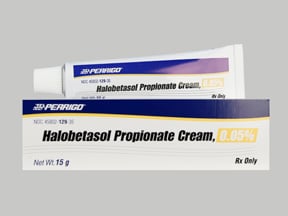
My prescription
Edit
15GM of 0.05%, Halobetasol (1 Tube)
Select pharmacy

CVS
$22.13
COUPON PRICE
Walmart
$13.18
COUPON PRICE
Walgreens
$16.35
COUPON PRICE
Albertsons
$38.46
COUPON PRICEHalobetasol savings card
Show this card to your pharmacist
Walmart
$13.18
BIN
ID
PCN
GRP
019876
LHF014CB4E
CHIPPO
LHX
Powered by
More prescriptions for skin allergy
More prescriptions for skin allergy
Price history for Bryhali (brand) & Halobetasol (generic)
1 Tube, 15GM of 0.05%
Average retail price for Bryhali
Average retail price for Halobetasol
Average SaveHealth price for Halobetasol
Our price history data is based on aggregated prescription data collected from participating pharmacies in America. Our prescription data updates daily to reflect the latest price changes. If you notice a missing data point, it means there wasn't sufficient data available to generate a monetary value for that date.
We analyzed Halobetasol prices for (15GM of 0.05%, 1 Tube) over the last 12 months. The average retail price was $54.74, while the average price using the SaveHealth discount card was $28.51. That's a savings of approximately 47.92% when using our Halobetasol coupon.
Compared to the generic version, Bryhali had an average price of $691.50 over the same time period. With the SaveHealth savings card, Halobetasol is 95.88% cheaper on average than Bryhali.
*Retail prices are based on pharmacy claims data, and may not be accurate when we don't have enough claims.
Halobetasol dosage forms
Dosage Quantity Price from Per unit 15GM of 0.05% 1 Tube $13.18 $13.18 15GM of 0.05% 2 Tubes $23.70 $11.85 15GM of 0.05% 3 Tubes $30.38 $10.13
| Dosage | Quantity | Price from | Per unit |
|---|---|---|---|
| 15GM of 0.05% | 1 Tube | $13.18 | $13.18 |
| 15GM of 0.05% | 2 Tubes | $23.70 | $11.85 |
| 15GM of 0.05% | 3 Tubes | $30.38 | $10.13 |
Halobetasol Warnings
This medication comes with important safety warnings that you should read carefully. If you have any questions or concerns, please consult your healthcare provider for guidance.
Altered Stress Hormone Levels: Prolonged use of topical steroids like halobetasol, especially on large skin areas or under tight bandages, can alter stress hormone levels. This risk increases with simultaneous use of multiple steroids, application on damaged skin, or in individuals with liver problems and young children.
Skin Reactions: Halobetasol may cause skin irritation such as dryness, itching, redness, bumps, stinging, burning, or rash. Long-term use or covering the treated area tightly can increase the likelihood of skin thinning, stretch marks, and spider veins. Inform your prescriber if you experience any persistent skin side effects.
Skin Infections: Discontinue use and contact your healthcare professional if you detect redness, warmth, tenderness, swelling, or pain on the treated skin, or if you experience fever or chills, as these could signify a skin infection that might need antibiotic treatment.
Vision Problems: Though uncommon, halobetasol may increase the risk of cataracts and glaucoma. Notify your healthcare provider if you have a history of vision problems or notice any changes in your eyesight while using this medication.
Flammability (Foam Version Only): The foam form of halobetasol is flammable. Keep it away from open flames and heat sources, including smoking. Store it in a cool, dry place and do not dispose of it in a fire, even if the canister appears empty.
Halobetasol Side Effects
Common side effects:
- Burning or stinging sensation
- Dryness
- Redness
- Itching on the skin
Less common but important to monitor:
- Pain at the application site
- Changes in skin color
- Acne
- Headache
Serious side effects:
- Stretch marks
- Skin thinning or discoloration
- Excessive hair growth
- Folliculitis
- Extreme tiredness
- Weight loss
- Swelling of the ankles or feet
- Increased thirst or urination
- Vision problems
- Serious allergic reaction
- Rash
- Severe dizziness
- Swelling of the face, tongue, or throat
- Difficulty breathing
Halobetasol Interactions
Halobetasol is a potent topical corticosteroid used to treat various skin conditions. While it is primarily applied to the skin, some of the medication can be absorbed into the bloodstream, potentially leading to interactions with other drugs or affecting certain medical conditions.
Potential Drug Interactions:
Diabetes Medications: When halobetasol is absorbed systemically, it may interfere with blood sugar control, potentially reducing the effectiveness of diabetes medications like Pioglitazone. This effect is more likely if halobetasol is used over large areas, on damaged skin, or under occlusive dressings. Patients with diabetes should monitor their blood sugar levels closely and consult their healthcare provider if they notice any changes.
Photosensitizing Agents: Halobetasol may increase the skin's sensitivity to sunlight. Using it alongside other photosensitizing drugs, such as thiazides, tetracyclines, fluoroquinolones, phenothiazines, or sulfonamides, can heighten the risk of sunburn. It's advisable to limit sun exposure and use protective measures like sunscreen and clothing while using halobetasol.
Considerations for Specific Medical Conditions:
Diabetes: Corticosteroids can raise blood glucose levels by affecting insulin action. Although topical corticosteroids like halobetasol rarely cause significant systemic effects, individuals with diabetes should use them cautiously and under medical supervision.
Skin Infections: Applying halobetasol to infected skin areas can worsen the infection. If a skin infection is present or develops during treatment, it's important to consult a healthcare provider.
Eye Conditions: Prolonged use of topical corticosteroids near the eyes may lead to increased intraocular pressure, potentially causing glaucoma or cataracts. Avoid applying halobetasol to the eye area unless directed by a healthcare professional.
General Recommendations:
Inform Healthcare Providers: Always inform your doctor about all medications, supplements, and herbal products you are using to assess potential interactions.
Follow Prescribed Guidelines: Use halobetasol exactly as prescribed. Avoid applying it to large areas, damaged skin, or using it under occlusive dressings unless directed by your doctor.
Monitor for Side Effects: Be vigilant for any unusual symptoms or side effects and report them to your healthcare provider promptly.
By adhering to these guidelines and maintaining open communication with your healthcare provider, you can use halobetasol safely and effectively.
